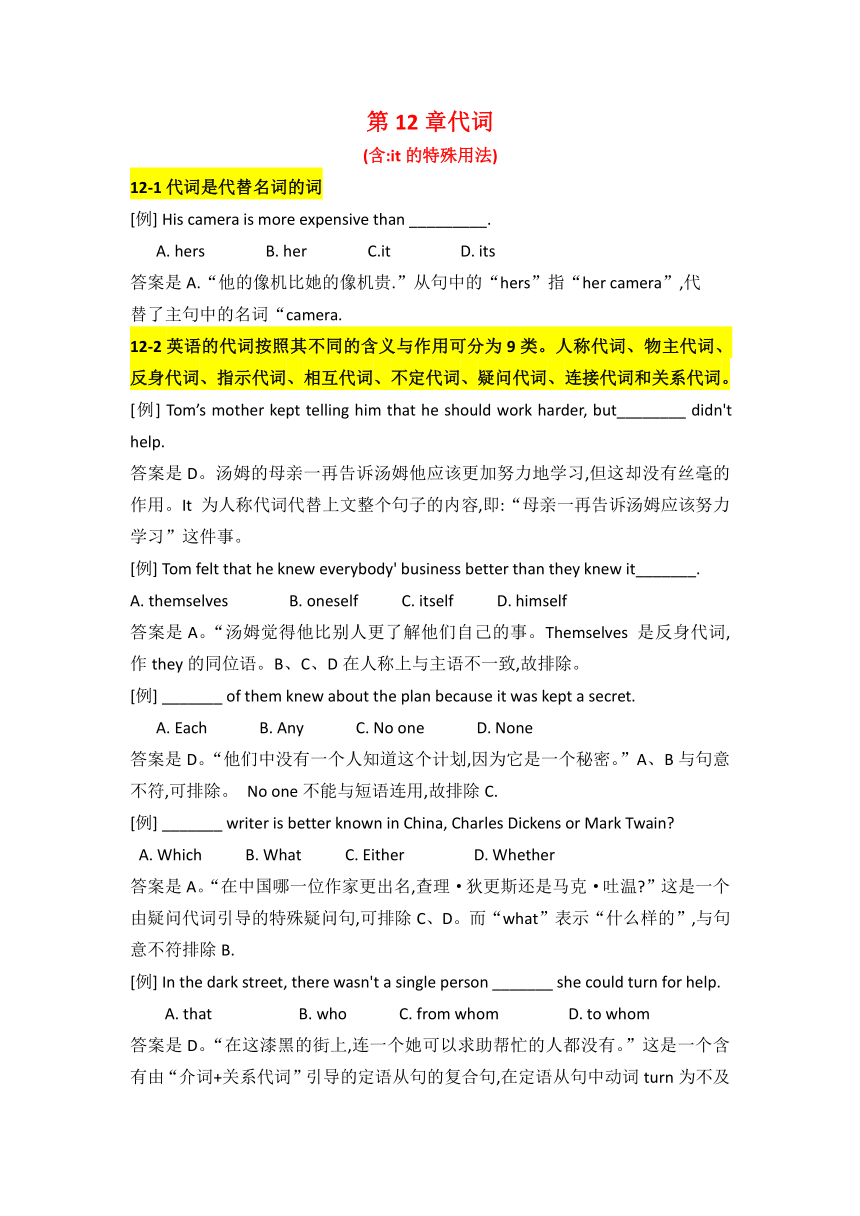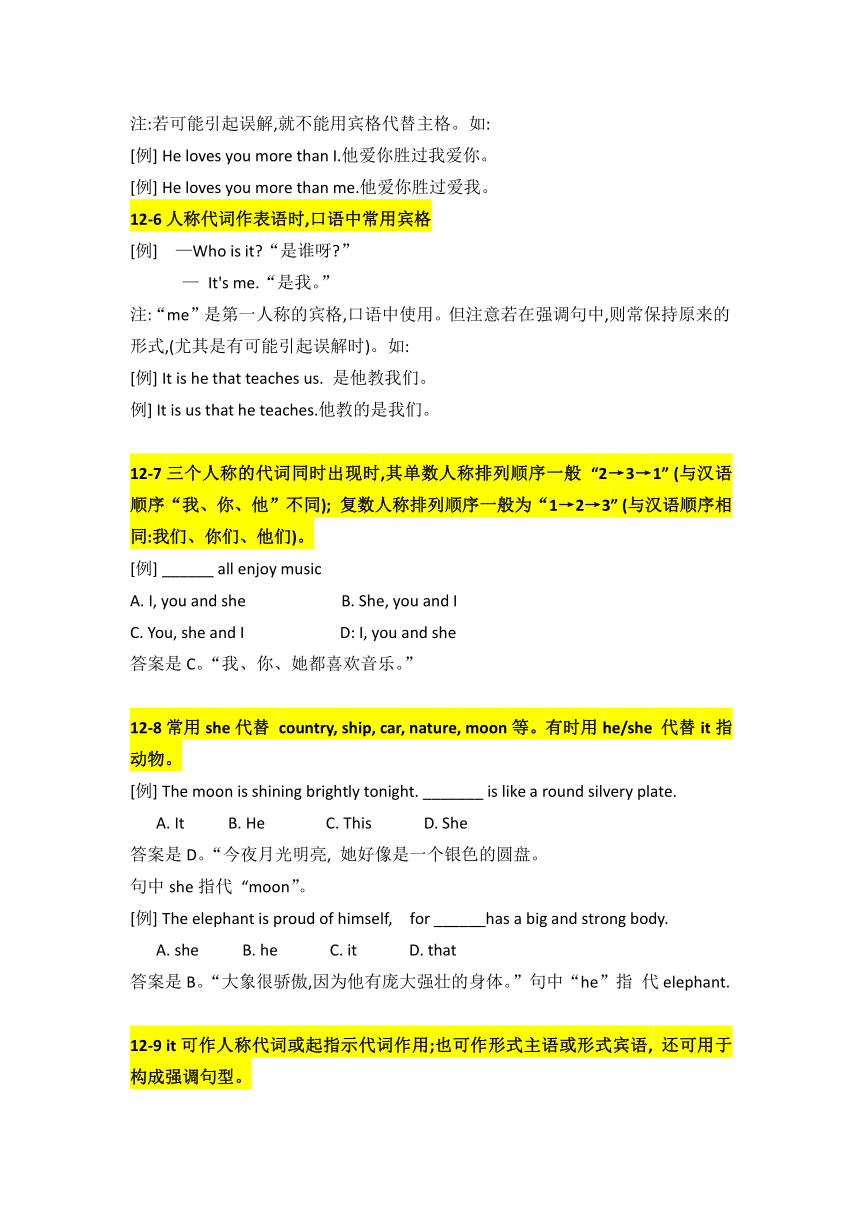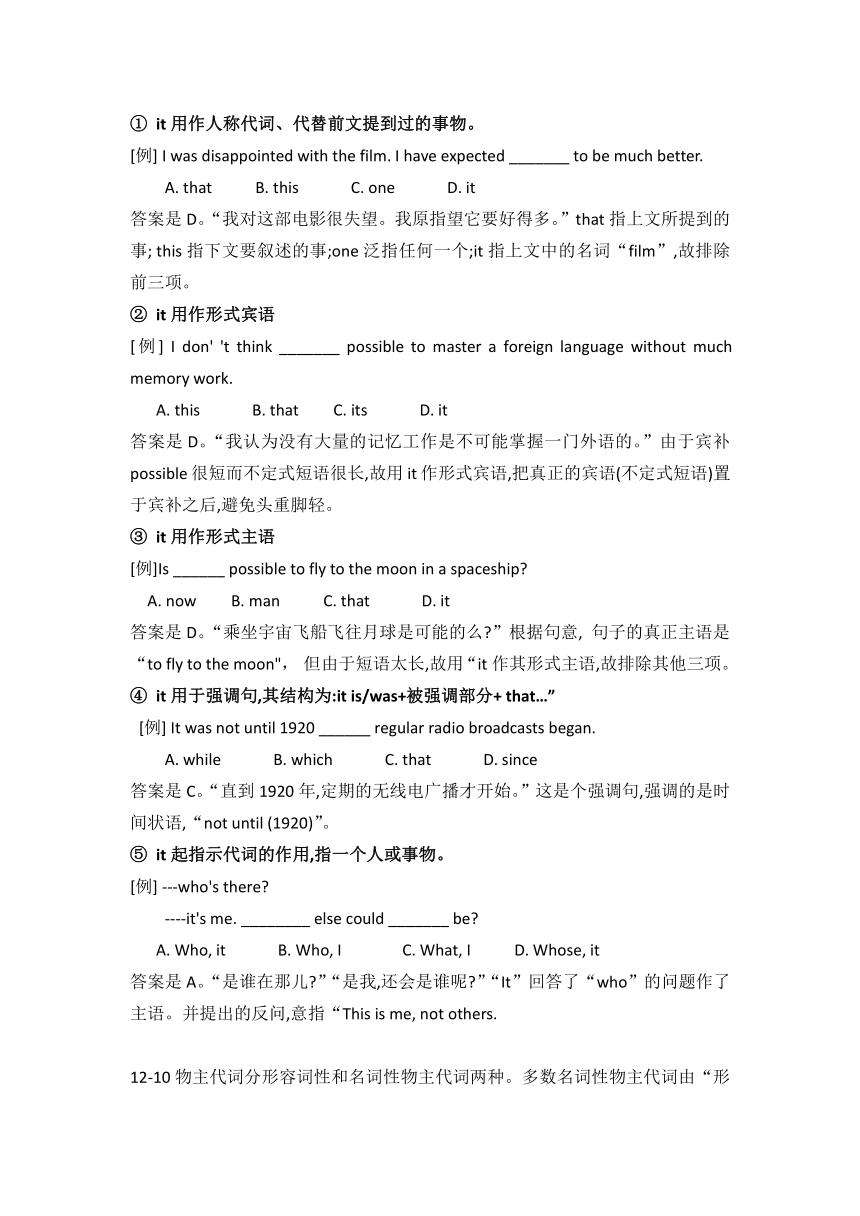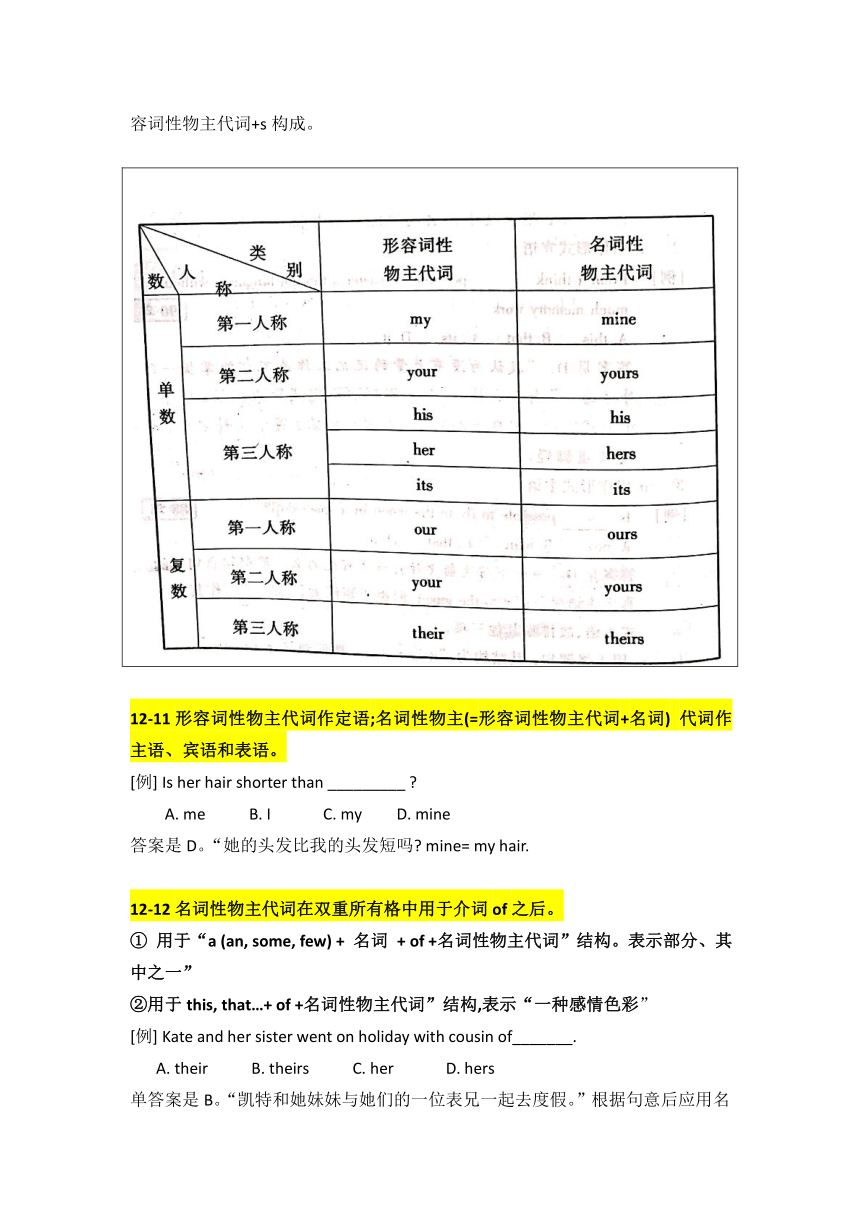代词(含:it的特殊用法)(英语语法第12章)讲义(含答案)-2025届高三英语二轮复习专项
文档属性
| 名称 | 代词(含:it的特殊用法)(英语语法第12章)讲义(含答案)-2025届高三英语二轮复习专项 |  | |
| 格式 | docx | ||
| 文件大小 | 1.3MB | ||
| 资源类型 | 教案 | ||
| 版本资源 | 人教版(2019) | ||
| 科目 | 英语 | ||
| 更新时间 | 2025-01-05 16:45:48 | ||
图片预览





文档简介
第12章代词
(含:it的特殊用法)
12-1代词是代替名词的词
[例] His camera is more expensive than _________.
A. hers B. her C.it D. its
答案是A.“他的像机比她的像机贵.”从句中的“hers”指“her camera”,代
替了主句中的名词“camera.
12-2英语的代词按照其不同的含义与作用可分为9类。人称代词、物主代词、反身代词、指示代词、相互代词、不定代词、疑问代词、连接代词和关系代词。
[例] Tom’s mother kept telling him that he should work harder, but________ didn't help.
答案是D。汤姆的母亲一再告诉汤姆他应该更加努力地学习,但这却没有丝毫的作用。It 为人称代词代替上文整个句子的内容,即:“母亲一再告诉汤姆应该努力学习”这件事。
[例] Tom felt that he knew everybody' business better than they knew it_______.
A. themselves B. oneself C. itself D. himself
答案是A。“汤姆觉得他比别人更了解他们自己的事。Themselves 是反身代词,作they的同位语。B、C、D在人称上与主语不一致,故排除。
[例] _______ of them knew about the plan because it was kept a secret.
A. Each B. Any C. No one D. None
答案是D。“他们中没有一个人知道这个计划,因为它是一个秘密。”A、B与句意不符,可排除。 No one不能与短语连用,故排除C.
[例] _______ writer is better known in China, Charles Dickens or Mark Twain
A. Which B. What C. Either D. Whether
答案是A。“在中国哪一位作家更出名,查理·狄更斯还是马克·吐温 ”这是一个由疑问代词引导的特殊疑问句,可排除C、D。而“what”表示“什么样的”,与句意不符排除B.
[例] In the dark street, there wasn't a single person _______ she could turn for help.
A. that B. who C. from whom D. to whom
答案是D。“在这漆黑的街上,连一个她可以求助帮忙的人都没有。”这是一个含有由“介词+关系代词”引导的定语从句的复合句,在定语从句中动词turn为不及物动词,得与介词to连用。whom为关系代词是介词“to”的宾语。
12-3人称代词主要是指人的代词。人称代词有人称、数和格的变化。
12-4主格代词常作主语、宾格代词常作动词或介词的宾语。
[例] Was_____ that I saw last night at the concert
A. it you B. not you C. you D. that yourself
答案是A。“昨天晚上我在音乐会上见到的人是你吗 ”这是强调句句型,其结构为“it + is/was +强调的部分+ that + …”。此句强调的是宾语故用宾格代词“you”表示。“it”为形式主语、不可省略。
[例] Neither _____ nor ______ liked the idea of going on foot.
A. him……me B. her….we
C. I them D. she….I
答案是D。“她和我都不喜欢步行去。”“Neither…nor""表示“既不…也不”作关联词用时,应连接相同的成份,此句应连接两个主语, 因此用主格代词,故排除A、B、C.
12-5在比较状语从句中,在不引起误解的前提下, 有时用宾格代词代替主格代词(尤其是其后跟有同位语all时)。
[例] He is taller than I (或me).他比我高。
He is taller than us all.他比我们都高。
注:若可能引起误解,就不能用宾格代替主格。如:
[例] He loves you more than I.他爱你胜过我爱你。
[例] He loves you more than me.他爱你胜过爱我。
12-6人称代词作表语时,口语中常用宾格
[例] —Who is it “是谁呀 ”
— It's me.“是我。”
注:“me”是第一人称的宾格,口语中使用。但注意若在强调句中,则常保持原来的形式,(尤其是有可能引起误解时)。如:
[例] It is he that teaches us. 是他教我们。
例] It is us that he teaches.他教的是我们。
12-7三个人称的代词同时出现时,其单数人称排列顺序一般 “2→3→1” (与汉语顺序“我、你、他”不同); 复数人称排列顺序一般为“1→2→3” (与汉语顺序相同:我们、你们、他们)。
[例] ______ all enjoy music
A. I, you and she B. She, you and I
C. You, she and I D: I, you and she
答案是C。“我、你、她都喜欢音乐。”
12-8常用she代替 country, ship, car, nature, moon等。有时用he/she 代替it指动物。
[例] The moon is shining brightly tonight. _______ is like a round silvery plate.
A. It B. He C. This D. She
答案是D。“今夜月光明亮, 她好像是一个银色的圆盘。
句中she指代 “moon”。
[例] The elephant is proud of himself, for ______has a big and strong body.
A. she B. he C. it D. that
答案是B。“大象很骄傲,因为他有庞大强壮的身体。”句中“he”指 代elephant.
12-9 it可作人称代词或起指示代词作用;也可作形式主语或形式宾语, 还可用于构成强调句型。
① it用作人称代词、代替前文提到过的事物。
[例] I was disappointed with the film. I have expected _______ to be much better.
A. that B. this C. one D. it
答案是D。“我对这部电影很失望。我原指望它要好得多。”that指上文所提到的事; this指下文要叙述的事;one泛指任何一个;it指上文中的名词“film”,故排除前三项。
② it用作形式宾语
[例] I don' 't think _______ possible to master a foreign language without much memory work.
A. this B. that C. its D. it
答案是D。“我认为没有大量的记忆工作是不可能掌握一门外语的。”由于宾补possible很短而不定式短语很长,故用it作形式宾语,把真正的宾语(不定式短语)置于宾补之后,避免头重脚轻。
③ it用作形式主语
[例]Is ______ possible to fly to the moon in a spaceship
A. now B. man C. that D. it
答案是D。“乘坐宇宙飞船飞往月球是可能的么 ”根据句意, 句子的真正主语是“to fly to the moon", 但由于短语太长,故用“it作其形式主语,故排除其他三项。
④ it用于强调句,其结构为:it is/was+被强调部分+ that…”
[例] It was not until 1920 ______ regular radio broadcasts began.
A. while B. which C. that D. since
答案是C。“直到1920年,定期的无线电广播才开始。”这是个强调句,强调的是时间状语,“not until (1920)”。
⑤ it起指示代词的作用,指一个人或事物。
[例] ---who's there
----it's me. ________ else could _______ be
A. Who, it B. Who, I C. What, I D. Whose, it
答案是A。“是谁在那儿 ”“是我,还会是谁呢 ”“It”回答了“who”的问题作了主语。并提出的反问,意指“This is me, not others.
12-10物主代词分形容词性和名词性物主代词两种。多数名词性物主代词由“形容词性物主代词+s构成。
12-11形容词性物主代词作定语;名词性物主(=形容词性物主代词+名词) 代词作主语、宾语和表语。
[例] Is her hair shorter than _________
A. me B. I C. my D. mine
答案是D。“她的头发比我的头发短吗 mine= my hair.
12-12名词性物主代词在双重所有格中用于介词of之后。
① 用于“a (an, some, few) + 名词 + of +名词性物主代词”结构。表示部分、其中之一”
②用于this, that…+ of +名词性物主代词”结构,表示“一种感彩”
[例] Kate and her sister went on holiday with cousin of_______.
A. their B. theirs C. her D. hers
单答案是B。“凯特和她妹妹与她们的一位表兄一起去度假。”根据句意后应用名词性物主代词,可排除A,C,因为 their和her都为形容词性物主代词。另外,因主语是两个人,名词性物主代词应第三人称复数形式,故选B, theirs= their cousins.
12-13反身代词有人称和数的变化。第一、二人称同“形容词性物主代词+ selves”构成;第三人称由“宾格代词+self/ selves构成。
12-14反身代词常用作宾语、同位语、也可用作表语。
[例] Tom felt that he knew everybody's business better than they knew it ________.
A. themselves B. oneself
C. itself D. himself
答案是A“汤姆觉得他了解每个人的事情比他们自己了解得更清楚”. 反身代词作主语they的同位语,是第三人称复数,故排除B、C、D.
[例] Speaking for _______ I can say: it was the most important single lesson of my life.
A. myself B. ourselves
C. themselves D. himself
答案是A。“就我个人而言,可以说是我一处中最重要的一课。”此句中“for”是介词,后跟反身代词作宾语。由于主语是第一人称单数, 故排除B、O、D
12-15“介词by/for/of/to+反身代词结构的用法区别
① by oneself单独、独自
[例] We did the experiment all by ourselves我们独自做实验。
② for oneself亲自
[例] You are free to decide for yourself who you are going out with.可以随意由自己决定和谁一道出去。”
③ of oneself自动
[例] The lamp went out of itself“灯自动灭了。”
④ to oneself独享、独有
[例] I can tell you that, but you must keep it to yourself.我可以告诉你, 但你必须保守秘密。”
12-16指示代词是表示空间上和时间上远近关系的词。有单数的this和that,复数的 these和 those,单复都可用的such和 same。
[例] She told us ______ story that we all forgot the time.
A. such an interesting B. such interesting
C. so an interesting D. a so an interesting
答案是A。“她给我们讲了一个这样有趣的故事,使我们大家都忘了时间”。注意搭配:“such + a(n)+形容词+单数可数名词”与“so+形容词+a(n)+单数可数名词”意思一样。
[例] The word“write” has the same pronunciation _______ the word “right”.
A. of B. as C. to D. from
答案是B。“write这个词的发音和 right'一词发音相同。"the same…as为固定搭配,表示“与…相同”引导定语从句。故排除其它三项。
①this/these指离说话者较近的空间或时间;而that/ those指离说话者较远的空间和时间。
②such作为指示代词,与名词连用表示“这样一个人或物”, “such…as” 表示“像这样的…”作定语或主语。
③ same用作的指示代词, 之前须用定冠词“the”,用作定语、主语、表语、宾语等。
12-17在打电话用语中,表述第一、二人称宜用指示代词this, that, 而不用人称代词“I或you”.
[例] ----Good morning. I’m ringing from the circulation department of the Daily Mirror to say…
---- __________
----A newspaper, dear lady. A famous newspaper.
A. What's that B. Who are you
答案是A。“早上好,我从《每日镜报》的发行部打电话想…”“你是哪位 ”“是一家报社,尊贵的夫人,是一家著名的报社。”在打电话 时,询问对方是“什么人”时不能用“Who are you ”而要用“Who's that 或“what's' that ”
12-18相互代词 each other与 one another都可表彼此”、“相互”,常可互换。one
another表示三个或更多个之间的相互关系(不能用于两者), 常用于正式文;而 each other则既可用于表两个又可用于表多个之间的相互关系。
[例] The two sisters love each other.这俩姐妹相亲相爱。
[例] They sat for two hours without talking to each other. (或: one another) 他们坐了两小时,彼此没说一句说。
12-19不定代词是那些用来指明代替任何特定名词(或形容词)的代词, 不定代词有名词和形容词的性质,并有可数与不可数之分。
12-20 不定代词all, both, each 在句中可作主语、宾语、定语和同位语。作同位语时,位于单个实义动词之前,单个be动词之后或第一个助动词或情态动词之后;each 还可位于句末。
[例] There are two windows in the room. They _____ face south.
A. all B. both C. each D. either
答案是B。“屋里有两扇窗户,他们都朝南。”both作主语they的同位语,位于单个实义动词face之前。
[例] I don' t know which book is the better. I shall read _____.
A. all B. both C. each D. either
答案是B。“我不知道哪本书更好,我要两本都读。”由于前句给出信息“the better"意指从两本书中“作选择”故排除A、D. 此处强调两本都读,要选both。both在句中作动词read宾语。
[例] Do September and April have thirty days ________
A. all. each C. every D. neither
答案是B。“九月和四月各有30天吗 ”根据句意,空白处是不定代词作主语的同位语,强调两者中的任意一个,要用each,位于句尾。 every和 neither都不能用作同位语,排除C、D. all和 every用于三个(或以上)的人或物,排除A、C。
注:在“all/both/each + of +the+名词”结构中,“of后面的“the”不可省略;若省去of时, all和both后面的“the可有可无。如:
all /both/each of the students;
both/all (the) students
12-21总括代词all/ each both/ everybody/everything等词与否定词not 连用时通常表示部分否定。
[例] Not all ants go out for food = All ants don’t go out for food. 并非所有的蚂蚁都出去觅食。(有的出去觅食, 有的留在家里。)
[例] Not everyone present understood what he said. 在场的不是人人都明白了他说的话。(有的明白了,有的没有。)
12-22总括代词all/each/both/ everybody/ everything的全部否定应改用否定代词none, no one, nobody, neither, nothing等。
[例] —Are the two answers correct
—No, _______ correct.
A. no one is B. both are not C. neither is D. either is not
答案是C。“这两个答案都对吗?”“不,两个都不对。”根据 “no” 可知表示全部否定。故排除B. no one指人与意不符。谓语动词为否定式时,主语不能用any或 either,排除D.
[例] _______ of them knew about the plan because _______ was kept a secret.
A. Each B. Any C. No one D. None
答案是D。“他们中没有一个人了解这个计划,因为它被保密。”根据从句意思“是秘密”可知应无人知晓,故排除A、B;而No one是泛指“无人”,不能与of连用,可排除C。 none可与of介短连用,故选D。[参见12-25]
12-23 one用于代替前面出现过的可数名词,它可有复数形式、所有格形式及反身代词形式。只有当one之前有形容词时, one才可与a/an连用;可泛指“人们”,在重复one和ones的地方可用he和his来代替。
[例] He has one blue pen and two red ________.
A. one B. ones C. one's D. once
答案是B。“他有一支蓝钢笔,两支红色的钢笔。”A虽指代“pen”, 但表单数,与“two”不相配。C为所有格,意思不对。D表“一次”“曾经”,与题意无关,故排除。B项ones表复数概念(pens)。
[例] Mr. Zhang gave the textbooks to all the pupils except ________who had.
A. the ones B. ones C. some D. the others
答案是A。“张老师把课本发给所有的学生那些已拿到课本的学生除外。ones指代前面的可数名词 pupils,但后面有who引导的限定性定语从句, 特指“那些拿到课本的学生,故而要在其前面加the。
[例] One should take care of one's (或his) health“人们应注意自己的健康。”
ones或his都可使用,无意义差别。
12-24不定代词one指“同一类”(可数)中的一个;人称代词it指前面所提到的“那一个”(单数可数或不可数);指示代词that指上文(单数可数或不可数);指示代词this既可指上文也可指下文(单数可数或不可数)。
[例] ---Have you found the bike you lost yesterday
---Yes I've found _______already.
A. the one B. it C. that D. this
答案是B。“你找到你昨天丢失的自行车了吗 ”“是的,我找到它了。”根据题意指上文提到的“the lost bike.”故而选B.
[例] I want a radio, but I haven’t got enough money to buy _________.
A. this B. that C. any D. one
答案是D。“我想要台收音机,但我还没有足够的钱来买一台。”空格词并不是指前边说的“那台radio。因此排除A、B。而C项不合句意,排除.
12-25 no one只泛指人”,后面不能与of介词短语连用,看作单数与单数谓语动词连用。none指“人”或“物”皆可,可与介词短语连用,可与单数或复数谓语动词连用。
[例] As we were asleep, ______ of us heard the sound
A. both B. none C. either D. any
答案是B。由于我们都睡着了; 我们没有一个人听到这声音。”
[例] We couldn't' eat in a restaurant because _______of us had _____money on us.
A. all, no B. any, no C. none, any D. no one, any
答案是C。“我们不能在饭馆里吃饭,因为我们中没有一人身上有钱。”
注:在回答“How many… ”问句时,用none而不用 no one
[例] ----How many fish did you catch 你钓了几条鱼
-----None.“一条也没钓着。”
12-26 either表示“两者中的任何一个”,与单数动词连用; neither表示两者中哪一个也不”,一般也是与单数动词连用.
[例] ----Can you come on Monday or Tuesday
----I'm afraid ______ day is possible.
A. either B. neither C. some D. any
答案是B。“你是周一能来还是周二 ”“恐怕都不行。”答语的前半句“I'm' afraid表示委婉的否定,因此要用neither,不用 either. 而some与any要用于三者或多者。
[例] ---Shall I sit at this end of the boat or the other end
----If you keep still, you can sit at ______end.
A. neither B. each C. either D. a
答案是C。“我坐在船这头,还是船那头呢 如果你不动, 哪头都行。
12-27 other泛指“另外的”,常与可数名词或不可数名词连用; others等于“other+复数名词”,泛指“别的人或物”。“the other (+单数可数名词)”指两者中的另一个,常用“one…, the other…”结构。 “the others”等于“the other+复数名词”,表示“其余所有的人或物。 another指“另(有)一个、再一个”“另外的任意一个”用作代词或形容词。
[例] Some people like to stay at home on Sunday but ________ like to go to the cinema.
A. another B. other C. others D. other one
答案是C。“星期天一些人喜欢呆在家里而另一些人喜欢去看电影。”根据动词 “like” 判断,其主语应为复数形式,故排除A,B,D.
[例]----Have you finished your report yet
----No, I'll finish in ________ ten minutes.
A. another B. other C. more D. less
答案是A。“你写完你的报告了吗 ”“没呢,再过个十分钟我就写完了。”根据句意,排除B、C、D. another+ 数词(one除外)+复数名词”表示“再…”,又如 need another five people“我需要再来五个人。”
12-28 some 表“一些”、“某些”、“某个”,any表“一些”、“任何”;都可修饰可数或不可数名词,都可作主语、宾语或定语等。some常用于肯定句; some用于疑问句时表示期望得到对方肯定答复或表建议。any常用于否定句,疑问句和条件从句; any用于肯定句时表示“任何的。
[例] I asked him for oil, but he hadn't ________.
A. any B. some C. no D. nothing
答案是A。“我向他要油,但他没有(任何)油了。”否定句中用any, 不用some。有否定词not时,不再用其它否定词no, nothing等
[例] Would you lend me some books please “请借我几本书好吗 用some表示期望对方给予肯定回答。
12-29表”许多”时,”many/many more/a (large) number of + 可数名词复数, “much / much more / a (great) deal of + 不可数名词”,a lot of/lots of/ plenty of+不可数名词或可数名词的复数。”
[例] I need ______ cloth, for I'm going to make clothes.
A. a lot of…many B. much…much
C. many…many D.many… lot of
答案是A。“我需要大量的布料,因为我要做许多衣服。”布料,为不可数名词,故而排除C、D。B中第二个空白后的名词为复数名词,不能用much修饰,故排除。
12-30表“少许时, few和 little趋于否定,而a few和 a little表示肯定; (a) few代替或修饰可数名词的复数,与复数动词配用, (a) little 代替或修饰不可数名词,与单数动词配用。它们在句中可作主语、宾语、定语等。
[例] ---Would you like some wine
----Yes ,just _________.
A. little B. very little C. a little D. little bit
答案是C。“你想喝点酒吗 ”“是的,只喝一点。 little表示肯定意义,排除A、B、C。
[例] We 've planted lot of apple trees , but because there has been no rain ______have born fruits.
A. some B. few C. a few D. the few
答案是B。“我们种了许多苹果树,但因无雨,所以很少结果实。”根据句意,应选择表示否定意义的词,故排除A、B、D
12-31 some/any/no/every/+-body/--thing/-one构成复合不定代词,作单数用。some-类词与any-类词在用法上的区别与some和any的区别一样。修饰它们的形容词要位于它们之后;当其后为else时,属格词s要加在else上(如: somebody else's bike).
[例]---Is ______here
----No, Bob and Tim have asked for leave.
A. anybody B. somebody C. everybody D. nobody
答案是C。“大家都到了吗 ”“不,鲍勃和蒂姆请假了。”
[例] There is something important in today’s newspaper.今天的报上有些重要新闻。”
虽然汉语里”something”可译作“一些”,但动词要用单数“is”.形容词important修饰 something,须放在 something之后。
1232疑问代词用来引出特殊疑问句,连接代词用来引名词性从句, 关系代词用来引导定语从句 [用法参见各有关章节]
[例]---Which skirt do you want to to buy for your daughter 你想给你女儿买哪件裙子
----I don't know which colour she likes best. Maybe I should buy the yollow skirt which has some red flowers on it.我不知道她最喜欢哪种颜色。也许我买那件上边有红花的黄裙子。
在句中有3个 which, 第①个 which是疑问代词;第②个 which是连接代词, 引出宾语从句;第③个 which是关系代词,引出定语从句,修饰skirt。
第12章“代词”专项能力训练题
单项填空:
1. ______of them understand the old foreigner.
A. Someone. B. Anyone
C. None D. Nobody
2. ----I feel a bit hungry.
----Why don't you have ______bread
A. any B. some C. little D. a
3. I've been expecting _______letters the whole morning, but there weren't ______for me.
A. some, any B. many, a few
C. some, some D. a few, none
4. Is ______ necessary to complete the design before National Day
A. this B. that C. it D. he
5. The boy promised _____ mother never to lie to _____again.
A. his; him; B. her; her C. her; him D. his; her
6. They were all tired, but ______of them would stop to have a rest.
A. any B. some C. none D. neither
7. ---There is a cookie left in that box.
----Help _____ to ______if you are hungry.
A. himself; one B. yourself….it
C. yourself…..the one D. himself...his
8. Canada is larger than ______ country in Asia.
A. any B. any other C. other D. another
9. They are talking _________.
A. each other B. one another
C. one to another D. to each other
10. Neither ________ nor ________ liked the idea of going on foot.
A. him…me B. her….we
C. I…them D. she...I
11. The apples on the table belong to me, but the ________ on the floor belong to Mary.
A. thing B. one C. ones D. one's
12. _______are good friends and should help each other.
A. I, you and he B. You, he and I
C. He, you and I D. You, I and he
13. She draws better than ______.
A. us all B. all us
C. other all D. our all
14. Was it in this place________ the last emperor died.
A. that B. in which C. in where D. which
15. You'd better come here ______instead of every day.
A. every two day B. every second days
C. every other day D. every few day
(含:it的特殊用法)
12-1代词是代替名词的词
[例] His camera is more expensive than _________.
A. hers B. her C.it D. its
答案是A.“他的像机比她的像机贵.”从句中的“hers”指“her camera”,代
替了主句中的名词“camera.
12-2英语的代词按照其不同的含义与作用可分为9类。人称代词、物主代词、反身代词、指示代词、相互代词、不定代词、疑问代词、连接代词和关系代词。
[例] Tom’s mother kept telling him that he should work harder, but________ didn't help.
答案是D。汤姆的母亲一再告诉汤姆他应该更加努力地学习,但这却没有丝毫的作用。It 为人称代词代替上文整个句子的内容,即:“母亲一再告诉汤姆应该努力学习”这件事。
[例] Tom felt that he knew everybody' business better than they knew it_______.
A. themselves B. oneself C. itself D. himself
答案是A。“汤姆觉得他比别人更了解他们自己的事。Themselves 是反身代词,作they的同位语。B、C、D在人称上与主语不一致,故排除。
[例] _______ of them knew about the plan because it was kept a secret.
A. Each B. Any C. No one D. None
答案是D。“他们中没有一个人知道这个计划,因为它是一个秘密。”A、B与句意不符,可排除。 No one不能与短语连用,故排除C.
[例] _______ writer is better known in China, Charles Dickens or Mark Twain
A. Which B. What C. Either D. Whether
答案是A。“在中国哪一位作家更出名,查理·狄更斯还是马克·吐温 ”这是一个由疑问代词引导的特殊疑问句,可排除C、D。而“what”表示“什么样的”,与句意不符排除B.
[例] In the dark street, there wasn't a single person _______ she could turn for help.
A. that B. who C. from whom D. to whom
答案是D。“在这漆黑的街上,连一个她可以求助帮忙的人都没有。”这是一个含有由“介词+关系代词”引导的定语从句的复合句,在定语从句中动词turn为不及物动词,得与介词to连用。whom为关系代词是介词“to”的宾语。
12-3人称代词主要是指人的代词。人称代词有人称、数和格的变化。
12-4主格代词常作主语、宾格代词常作动词或介词的宾语。
[例] Was_____ that I saw last night at the concert
A. it you B. not you C. you D. that yourself
答案是A。“昨天晚上我在音乐会上见到的人是你吗 ”这是强调句句型,其结构为“it + is/was +强调的部分+ that + …”。此句强调的是宾语故用宾格代词“you”表示。“it”为形式主语、不可省略。
[例] Neither _____ nor ______ liked the idea of going on foot.
A. him……me B. her….we
C. I them D. she….I
答案是D。“她和我都不喜欢步行去。”“Neither…nor""表示“既不…也不”作关联词用时,应连接相同的成份,此句应连接两个主语, 因此用主格代词,故排除A、B、C.
12-5在比较状语从句中,在不引起误解的前提下, 有时用宾格代词代替主格代词(尤其是其后跟有同位语all时)。
[例] He is taller than I (或me).他比我高。
He is taller than us all.他比我们都高。
注:若可能引起误解,就不能用宾格代替主格。如:
[例] He loves you more than I.他爱你胜过我爱你。
[例] He loves you more than me.他爱你胜过爱我。
12-6人称代词作表语时,口语中常用宾格
[例] —Who is it “是谁呀 ”
— It's me.“是我。”
注:“me”是第一人称的宾格,口语中使用。但注意若在强调句中,则常保持原来的形式,(尤其是有可能引起误解时)。如:
[例] It is he that teaches us. 是他教我们。
例] It is us that he teaches.他教的是我们。
12-7三个人称的代词同时出现时,其单数人称排列顺序一般 “2→3→1” (与汉语顺序“我、你、他”不同); 复数人称排列顺序一般为“1→2→3” (与汉语顺序相同:我们、你们、他们)。
[例] ______ all enjoy music
A. I, you and she B. She, you and I
C. You, she and I D: I, you and she
答案是C。“我、你、她都喜欢音乐。”
12-8常用she代替 country, ship, car, nature, moon等。有时用he/she 代替it指动物。
[例] The moon is shining brightly tonight. _______ is like a round silvery plate.
A. It B. He C. This D. She
答案是D。“今夜月光明亮, 她好像是一个银色的圆盘。
句中she指代 “moon”。
[例] The elephant is proud of himself, for ______has a big and strong body.
A. she B. he C. it D. that
答案是B。“大象很骄傲,因为他有庞大强壮的身体。”句中“he”指 代elephant.
12-9 it可作人称代词或起指示代词作用;也可作形式主语或形式宾语, 还可用于构成强调句型。
① it用作人称代词、代替前文提到过的事物。
[例] I was disappointed with the film. I have expected _______ to be much better.
A. that B. this C. one D. it
答案是D。“我对这部电影很失望。我原指望它要好得多。”that指上文所提到的事; this指下文要叙述的事;one泛指任何一个;it指上文中的名词“film”,故排除前三项。
② it用作形式宾语
[例] I don' 't think _______ possible to master a foreign language without much memory work.
A. this B. that C. its D. it
答案是D。“我认为没有大量的记忆工作是不可能掌握一门外语的。”由于宾补possible很短而不定式短语很长,故用it作形式宾语,把真正的宾语(不定式短语)置于宾补之后,避免头重脚轻。
③ it用作形式主语
[例]Is ______ possible to fly to the moon in a spaceship
A. now B. man C. that D. it
答案是D。“乘坐宇宙飞船飞往月球是可能的么 ”根据句意, 句子的真正主语是“to fly to the moon", 但由于短语太长,故用“it作其形式主语,故排除其他三项。
④ it用于强调句,其结构为:it is/was+被强调部分+ that…”
[例] It was not until 1920 ______ regular radio broadcasts began.
A. while B. which C. that D. since
答案是C。“直到1920年,定期的无线电广播才开始。”这是个强调句,强调的是时间状语,“not until (1920)”。
⑤ it起指示代词的作用,指一个人或事物。
[例] ---who's there
----it's me. ________ else could _______ be
A. Who, it B. Who, I C. What, I D. Whose, it
答案是A。“是谁在那儿 ”“是我,还会是谁呢 ”“It”回答了“who”的问题作了主语。并提出的反问,意指“This is me, not others.
12-10物主代词分形容词性和名词性物主代词两种。多数名词性物主代词由“形容词性物主代词+s构成。
12-11形容词性物主代词作定语;名词性物主(=形容词性物主代词+名词) 代词作主语、宾语和表语。
[例] Is her hair shorter than _________
A. me B. I C. my D. mine
答案是D。“她的头发比我的头发短吗 mine= my hair.
12-12名词性物主代词在双重所有格中用于介词of之后。
① 用于“a (an, some, few) + 名词 + of +名词性物主代词”结构。表示部分、其中之一”
②用于this, that…+ of +名词性物主代词”结构,表示“一种感彩”
[例] Kate and her sister went on holiday with cousin of_______.
A. their B. theirs C. her D. hers
单答案是B。“凯特和她妹妹与她们的一位表兄一起去度假。”根据句意后应用名词性物主代词,可排除A,C,因为 their和her都为形容词性物主代词。另外,因主语是两个人,名词性物主代词应第三人称复数形式,故选B, theirs= their cousins.
12-13反身代词有人称和数的变化。第一、二人称同“形容词性物主代词+ selves”构成;第三人称由“宾格代词+self/ selves构成。
12-14反身代词常用作宾语、同位语、也可用作表语。
[例] Tom felt that he knew everybody's business better than they knew it ________.
A. themselves B. oneself
C. itself D. himself
答案是A“汤姆觉得他了解每个人的事情比他们自己了解得更清楚”. 反身代词作主语they的同位语,是第三人称复数,故排除B、C、D.
[例] Speaking for _______ I can say: it was the most important single lesson of my life.
A. myself B. ourselves
C. themselves D. himself
答案是A。“就我个人而言,可以说是我一处中最重要的一课。”此句中“for”是介词,后跟反身代词作宾语。由于主语是第一人称单数, 故排除B、O、D
12-15“介词by/for/of/to+反身代词结构的用法区别
① by oneself单独、独自
[例] We did the experiment all by ourselves我们独自做实验。
② for oneself亲自
[例] You are free to decide for yourself who you are going out with.可以随意由自己决定和谁一道出去。”
③ of oneself自动
[例] The lamp went out of itself“灯自动灭了。”
④ to oneself独享、独有
[例] I can tell you that, but you must keep it to yourself.我可以告诉你, 但你必须保守秘密。”
12-16指示代词是表示空间上和时间上远近关系的词。有单数的this和that,复数的 these和 those,单复都可用的such和 same。
[例] She told us ______ story that we all forgot the time.
A. such an interesting B. such interesting
C. so an interesting D. a so an interesting
答案是A。“她给我们讲了一个这样有趣的故事,使我们大家都忘了时间”。注意搭配:“such + a(n)+形容词+单数可数名词”与“so+形容词+a(n)+单数可数名词”意思一样。
[例] The word“write” has the same pronunciation _______ the word “right”.
A. of B. as C. to D. from
答案是B。“write这个词的发音和 right'一词发音相同。"the same…as为固定搭配,表示“与…相同”引导定语从句。故排除其它三项。
①this/these指离说话者较近的空间或时间;而that/ those指离说话者较远的空间和时间。
②such作为指示代词,与名词连用表示“这样一个人或物”, “such…as” 表示“像这样的…”作定语或主语。
③ same用作的指示代词, 之前须用定冠词“the”,用作定语、主语、表语、宾语等。
12-17在打电话用语中,表述第一、二人称宜用指示代词this, that, 而不用人称代词“I或you”.
[例] ----Good morning. I’m ringing from the circulation department of the Daily Mirror to say…
---- __________
----A newspaper, dear lady. A famous newspaper.
A. What's that B. Who are you
答案是A。“早上好,我从《每日镜报》的发行部打电话想…”“你是哪位 ”“是一家报社,尊贵的夫人,是一家著名的报社。”在打电话 时,询问对方是“什么人”时不能用“Who are you ”而要用“Who's that 或“what's' that ”
12-18相互代词 each other与 one another都可表彼此”、“相互”,常可互换。one
another表示三个或更多个之间的相互关系(不能用于两者), 常用于正式文;而 each other则既可用于表两个又可用于表多个之间的相互关系。
[例] The two sisters love each other.这俩姐妹相亲相爱。
[例] They sat for two hours without talking to each other. (或: one another) 他们坐了两小时,彼此没说一句说。
12-19不定代词是那些用来指明代替任何特定名词(或形容词)的代词, 不定代词有名词和形容词的性质,并有可数与不可数之分。
12-20 不定代词all, both, each 在句中可作主语、宾语、定语和同位语。作同位语时,位于单个实义动词之前,单个be动词之后或第一个助动词或情态动词之后;each 还可位于句末。
[例] There are two windows in the room. They _____ face south.
A. all B. both C. each D. either
答案是B。“屋里有两扇窗户,他们都朝南。”both作主语they的同位语,位于单个实义动词face之前。
[例] I don' t know which book is the better. I shall read _____.
A. all B. both C. each D. either
答案是B。“我不知道哪本书更好,我要两本都读。”由于前句给出信息“the better"意指从两本书中“作选择”故排除A、D. 此处强调两本都读,要选both。both在句中作动词read宾语。
[例] Do September and April have thirty days ________
A. all. each C. every D. neither
答案是B。“九月和四月各有30天吗 ”根据句意,空白处是不定代词作主语的同位语,强调两者中的任意一个,要用each,位于句尾。 every和 neither都不能用作同位语,排除C、D. all和 every用于三个(或以上)的人或物,排除A、C。
注:在“all/both/each + of +the+名词”结构中,“of后面的“the”不可省略;若省去of时, all和both后面的“the可有可无。如:
all /both/each of the students;
both/all (the) students
12-21总括代词all/ each both/ everybody/everything等词与否定词not 连用时通常表示部分否定。
[例] Not all ants go out for food = All ants don’t go out for food. 并非所有的蚂蚁都出去觅食。(有的出去觅食, 有的留在家里。)
[例] Not everyone present understood what he said. 在场的不是人人都明白了他说的话。(有的明白了,有的没有。)
12-22总括代词all/each/both/ everybody/ everything的全部否定应改用否定代词none, no one, nobody, neither, nothing等。
[例] —Are the two answers correct
—No, _______ correct.
A. no one is B. both are not C. neither is D. either is not
答案是C。“这两个答案都对吗?”“不,两个都不对。”根据 “no” 可知表示全部否定。故排除B. no one指人与意不符。谓语动词为否定式时,主语不能用any或 either,排除D.
[例] _______ of them knew about the plan because _______ was kept a secret.
A. Each B. Any C. No one D. None
答案是D。“他们中没有一个人了解这个计划,因为它被保密。”根据从句意思“是秘密”可知应无人知晓,故排除A、B;而No one是泛指“无人”,不能与of连用,可排除C。 none可与of介短连用,故选D。[参见12-25]
12-23 one用于代替前面出现过的可数名词,它可有复数形式、所有格形式及反身代词形式。只有当one之前有形容词时, one才可与a/an连用;可泛指“人们”,在重复one和ones的地方可用he和his来代替。
[例] He has one blue pen and two red ________.
A. one B. ones C. one's D. once
答案是B。“他有一支蓝钢笔,两支红色的钢笔。”A虽指代“pen”, 但表单数,与“two”不相配。C为所有格,意思不对。D表“一次”“曾经”,与题意无关,故排除。B项ones表复数概念(pens)。
[例] Mr. Zhang gave the textbooks to all the pupils except ________who had.
A. the ones B. ones C. some D. the others
答案是A。“张老师把课本发给所有的学生那些已拿到课本的学生除外。ones指代前面的可数名词 pupils,但后面有who引导的限定性定语从句, 特指“那些拿到课本的学生,故而要在其前面加the。
[例] One should take care of one's (或his) health“人们应注意自己的健康。”
ones或his都可使用,无意义差别。
12-24不定代词one指“同一类”(可数)中的一个;人称代词it指前面所提到的“那一个”(单数可数或不可数);指示代词that指上文(单数可数或不可数);指示代词this既可指上文也可指下文(单数可数或不可数)。
[例] ---Have you found the bike you lost yesterday
---Yes I've found _______already.
A. the one B. it C. that D. this
答案是B。“你找到你昨天丢失的自行车了吗 ”“是的,我找到它了。”根据题意指上文提到的“the lost bike.”故而选B.
[例] I want a radio, but I haven’t got enough money to buy _________.
A. this B. that C. any D. one
答案是D。“我想要台收音机,但我还没有足够的钱来买一台。”空格词并不是指前边说的“那台radio。因此排除A、B。而C项不合句意,排除.
12-25 no one只泛指人”,后面不能与of介词短语连用,看作单数与单数谓语动词连用。none指“人”或“物”皆可,可与介词短语连用,可与单数或复数谓语动词连用。
[例] As we were asleep, ______ of us heard the sound
A. both B. none C. either D. any
答案是B。由于我们都睡着了; 我们没有一个人听到这声音。”
[例] We couldn't' eat in a restaurant because _______of us had _____money on us.
A. all, no B. any, no C. none, any D. no one, any
答案是C。“我们不能在饭馆里吃饭,因为我们中没有一人身上有钱。”
注:在回答“How many… ”问句时,用none而不用 no one
[例] ----How many fish did you catch 你钓了几条鱼
-----None.“一条也没钓着。”
12-26 either表示“两者中的任何一个”,与单数动词连用; neither表示两者中哪一个也不”,一般也是与单数动词连用.
[例] ----Can you come on Monday or Tuesday
----I'm afraid ______ day is possible.
A. either B. neither C. some D. any
答案是B。“你是周一能来还是周二 ”“恐怕都不行。”答语的前半句“I'm' afraid表示委婉的否定,因此要用neither,不用 either. 而some与any要用于三者或多者。
[例] ---Shall I sit at this end of the boat or the other end
----If you keep still, you can sit at ______end.
A. neither B. each C. either D. a
答案是C。“我坐在船这头,还是船那头呢 如果你不动, 哪头都行。
12-27 other泛指“另外的”,常与可数名词或不可数名词连用; others等于“other+复数名词”,泛指“别的人或物”。“the other (+单数可数名词)”指两者中的另一个,常用“one…, the other…”结构。 “the others”等于“the other+复数名词”,表示“其余所有的人或物。 another指“另(有)一个、再一个”“另外的任意一个”用作代词或形容词。
[例] Some people like to stay at home on Sunday but ________ like to go to the cinema.
A. another B. other C. others D. other one
答案是C。“星期天一些人喜欢呆在家里而另一些人喜欢去看电影。”根据动词 “like” 判断,其主语应为复数形式,故排除A,B,D.
[例]----Have you finished your report yet
----No, I'll finish in ________ ten minutes.
A. another B. other C. more D. less
答案是A。“你写完你的报告了吗 ”“没呢,再过个十分钟我就写完了。”根据句意,排除B、C、D. another+ 数词(one除外)+复数名词”表示“再…”,又如 need another five people“我需要再来五个人。”
12-28 some 表“一些”、“某些”、“某个”,any表“一些”、“任何”;都可修饰可数或不可数名词,都可作主语、宾语或定语等。some常用于肯定句; some用于疑问句时表示期望得到对方肯定答复或表建议。any常用于否定句,疑问句和条件从句; any用于肯定句时表示“任何的。
[例] I asked him for oil, but he hadn't ________.
A. any B. some C. no D. nothing
答案是A。“我向他要油,但他没有(任何)油了。”否定句中用any, 不用some。有否定词not时,不再用其它否定词no, nothing等
[例] Would you lend me some books please “请借我几本书好吗 用some表示期望对方给予肯定回答。
12-29表”许多”时,”many/many more/a (large) number of + 可数名词复数, “much / much more / a (great) deal of + 不可数名词”,a lot of/lots of/ plenty of+不可数名词或可数名词的复数。”
[例] I need ______ cloth, for I'm going to make clothes.
A. a lot of…many B. much…much
C. many…many D.many… lot of
答案是A。“我需要大量的布料,因为我要做许多衣服。”布料,为不可数名词,故而排除C、D。B中第二个空白后的名词为复数名词,不能用much修饰,故排除。
12-30表“少许时, few和 little趋于否定,而a few和 a little表示肯定; (a) few代替或修饰可数名词的复数,与复数动词配用, (a) little 代替或修饰不可数名词,与单数动词配用。它们在句中可作主语、宾语、定语等。
[例] ---Would you like some wine
----Yes ,just _________.
A. little B. very little C. a little D. little bit
答案是C。“你想喝点酒吗 ”“是的,只喝一点。 little表示肯定意义,排除A、B、C。
[例] We 've planted lot of apple trees , but because there has been no rain ______have born fruits.
A. some B. few C. a few D. the few
答案是B。“我们种了许多苹果树,但因无雨,所以很少结果实。”根据句意,应选择表示否定意义的词,故排除A、B、D
12-31 some/any/no/every/+-body/--thing/-one构成复合不定代词,作单数用。some-类词与any-类词在用法上的区别与some和any的区别一样。修饰它们的形容词要位于它们之后;当其后为else时,属格词s要加在else上(如: somebody else's bike).
[例]---Is ______here
----No, Bob and Tim have asked for leave.
A. anybody B. somebody C. everybody D. nobody
答案是C。“大家都到了吗 ”“不,鲍勃和蒂姆请假了。”
[例] There is something important in today’s newspaper.今天的报上有些重要新闻。”
虽然汉语里”something”可译作“一些”,但动词要用单数“is”.形容词important修饰 something,须放在 something之后。
1232疑问代词用来引出特殊疑问句,连接代词用来引名词性从句, 关系代词用来引导定语从句 [用法参见各有关章节]
[例]---Which skirt do you want to to buy for your daughter 你想给你女儿买哪件裙子
----I don't know which colour she likes best. Maybe I should buy the yollow skirt which has some red flowers on it.我不知道她最喜欢哪种颜色。也许我买那件上边有红花的黄裙子。
在句中有3个 which, 第①个 which是疑问代词;第②个 which是连接代词, 引出宾语从句;第③个 which是关系代词,引出定语从句,修饰skirt。
第12章“代词”专项能力训练题
单项填空:
1. ______of them understand the old foreigner.
A. Someone. B. Anyone
C. None D. Nobody
2. ----I feel a bit hungry.
----Why don't you have ______bread
A. any B. some C. little D. a
3. I've been expecting _______letters the whole morning, but there weren't ______for me.
A. some, any B. many, a few
C. some, some D. a few, none
4. Is ______ necessary to complete the design before National Day
A. this B. that C. it D. he
5. The boy promised _____ mother never to lie to _____again.
A. his; him; B. her; her C. her; him D. his; her
6. They were all tired, but ______of them would stop to have a rest.
A. any B. some C. none D. neither
7. ---There is a cookie left in that box.
----Help _____ to ______if you are hungry.
A. himself; one B. yourself….it
C. yourself…..the one D. himself...his
8. Canada is larger than ______ country in Asia.
A. any B. any other C. other D. another
9. They are talking _________.
A. each other B. one another
C. one to another D. to each other
10. Neither ________ nor ________ liked the idea of going on foot.
A. him…me B. her….we
C. I…them D. she...I
11. The apples on the table belong to me, but the ________ on the floor belong to Mary.
A. thing B. one C. ones D. one's
12. _______are good friends and should help each other.
A. I, you and he B. You, he and I
C. He, you and I D. You, I and he
13. She draws better than ______.
A. us all B. all us
C. other all D. our all
14. Was it in this place________ the last emperor died.
A. that B. in which C. in where D. which
15. You'd better come here ______instead of every day.
A. every two day B. every second days
C. every other day D. every few day
